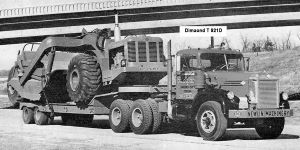 The Diamond T 921 was a rugged and adaptable workhorse that made a lasting impression in industries demanding heavy-duty reliability. Produced from the late 1950s through the 1960s, this Class 8 truck became popular in logging, construction, and other heavy-haul applications. Known for its sturdy frame and versatility, the 921 was available in both conventional and cab-over-engine (COE) configurations, though the classic long-nose conventional style was the most iconic.
The Diamond T 921 was a rugged and adaptable workhorse that made a lasting impression in industries demanding heavy-duty reliability. Produced from the late 1950s through the 1960s, this Class 8 truck became popular in logging, construction, and other heavy-haul applications. Known for its sturdy frame and versatility, the 921 was available in both conventional and cab-over-engine (COE) configurations, though the classic long-nose conventional style was the most iconic.
Performance and Versatility
The 921 was offered with options for single or tandem rear axles, enabling it to handle a wide range of payload capacities. Its robust chassis supported various customizations, such as extended frames, winches, and reinforced beds. This adaptability made it ideal for specialized roles in logging, where it could be equipped with log bunks, or in construction, where it served as a reliable transport for heavy equipment and materials.
Industrial Applications
The Diamond T 921 was widely valued in the logging industry for its durability and strength, enabling it to transport timber from remote, off-road locations. Construction companies relied on the 921’s ability to haul machinery and materials to job sites, while it also saw use in regional freight transport, where reliability was crucial. With optional power take-off (PTO) systems, the 921 could support specialized equipment, making it a versatile choice for various heavy-duty applications.
Diamond T 921 variants:
Diamond T 921 (Standard Single Axle)
Basic model with a single rear axle (4x2).
Used in lighter Class 8 applications, such as regional freight.
 Diamond T 921-T (Tandem Axle)
Diamond T 921-T (Tandem Axle)
Tandem axle (6x4) for heavier loads. Ideal for logging and construction, where extra traction and load capacity were essential.
Diamond T 921-C (Construction Variant)
 Tailored for construction and rugged environments.
Tailored for construction and rugged environments.
Reinforced frame and suspension for durability on tough terrains and demanding job sites.
Diamond T 921PT (Power Take-Off)
Equipped with a power take-off system.
Used for specialized work with auxiliary equipment like winches and pumps, often in municipal or construction roles.
Diamond T 921 COE (Cab-Over-Engine)
Less common cab-over-engine model, offering better maneuverability.
Suited for urban and regional applications, though rarely marketed directly as the 921.
Diamond T 921FN
Tandem axle model (6x4), designed for heavy-duty hauling in demanding industries.
Often equipped with a Cummins NH180 engine, Fuller Roadranger R96 transmission, and Eaton rear ends, supported by Hendrickson suspension.
Diamond T 921DN
Diesel-engine variant with a focus on substantial hauling capacity.
Commonly equipped with a Cummins NH180 engine and tandem axles.
Diamond T 921DFN
Diesel-powered with a tandem axle (6x4) setup for even heavier-duty applications.
Often fitted with a Cummins NH180 engine, Fuller Roadranger transmission, and Eaton rear ends, supported by Hendrickson suspension for extra stability.
Diamond T 921FR
Tandem axle model (6x4) with a configuration suited to high-stability heavy hauling. Known for its robust construction, the 921FR handled substantial payloads in industries requiring strong traction and load support.
Diamond T 921BN
A variant from the late 1950s, sometimes seen in collections today.
Like the other tandem axle models, the 921BN was suited for substantial hauling capabilities.
Diamond T 921D
Diesel-powered twin-screw tandem axle model, often used in the early 1960s.
Equipped with additional rear axle traction, making it ideal for heavy-duty applications like construction and towing.
Want to dig deeper into trucking history? The ATHS membership-supported Zoe James Memorial Library is home to thousands of classic truck photos, periodicals, and documents. Check it out at aths.org/zoe-james-memorial-library.